Hassan Ibrahim | Hussam al-Mahmoud | Khaled al-Jeratli
From an agricultural country that is self-sufficient in strategic crops to a country whose wealth and agricultural resources are collapsing, and where hunger affects more than 12.1 million people who suffer from food insecurity, as the agricultural sector was not spared from the damage that affected all aspects of life in Syria over the course of 12 years.
Agriculture constituted about 33% of the country’s domestic product before 2010, then decreased to 17%, and it is not known where the situation has reached today, with the constant collapse of the sector.
Strategic crops of wheat, cotton, sugar beets, olives, and citrus fruits, which were a source of income for the population and a support for the local economy in terms of production and export, have declined, and their cultivation area has shrunk, which has a devastating impact on farmers and the economy and changes the country’s lifestyle.
Syria’s farmers in the four areas of control suffer from a lack of support, an increase in the prices of their agricultural supplies, a lack of markets to sell their products, and the controlling authorities set prices for crops that are not commensurate with the costs of agriculture and do not leave a profit margin for the farmer as the increase in production is reflected in the farmer’s loss, and abundant production means lower crop prices.
Amid indications that what is coming is worse, in this file, Enab Baladi sheds light on the reality of strategic agriculture and crops in Syria and discusses with economists, experts, agricultural engineers and farmers the reasons for their decline. Enab Baladi also examines the impact of this on the farmer, the population and the economy, and the impacts of the deterioration of the agricultural sector.
Statistics show agriculture sector is declining
Wheat is considered one of the main strategic crops in Syria, and the average production of the crop from 1990 to 2010 was more than 4 million tons. In 2006, Syria recorded the highest number in its production at 4.9 million tons, according to the Central Bureau of Statistics, the average domestic consumption was 2.5 million tons, which provided an export surplus of between 1.2 and 1.5 million tons.
The quantities received from the wheat season in regime-controlled areas for this year amounted to 725,000 tons, and the regime’s government set three prices for purchasing a kilo, which it issued gradually following sharp criticism that the price was not commensurate with the costs.
The first price was on April 18 and amounted to 2,300 Syrian pounds (About 30 USD cents). Then, the price of one kilogram was set again at 2,500 Syrian pounds, in addition to an amount of 300 Syrian pounds as “encouragement incentives,” bringing the price to 2,800 pounds per kilo.
The US dollar is trading at 14,000 SYP according to the S-P Today website, which covers the trading rate of the Syrian pound to the dollar. At the start of the conflict in 2011, the dollar was trading at 47 pounds.
Due to the small quantities received from the eastern regions of Syria, Prime Minister Hussein Arnous announced that farmers would be granted an “encouragement reward” of 200 Syrian pounds for every kilogram of wheat delivered this year to the centers of the General Establishment for Cereal Processing and Trade (Hoboob) in Deir Ezzor governorate.
For years, the regime’s government has been securing wheat from Russia in various ways and methods, including through bilateral agreements whose details are rarely revealed, or through tenders put out by the state-run Hoboob to buy wheat, or through quantities that Russia sends and calls aid or Moscow’s “theft” of Ukrainian wheat and sending some of it to Syria, according to what was revealed by Ukrainian official bodies and news agencies, despite the Syrian regime’s denial.
In Kurdish-held northeastern Syria, the Autonomous Administration of North and East Syria (AANES) bought from farmers 1,150,000 tons of wheat production for the current year’s harvest season at a price of 43 cents of the dollar per kilogram (3,700 Syrian pounds). But the AANES announced on July 31 the cessation of buying operations.
The Syrian Salvation Government (SSG), the administrative and governing body in Hayat Tahrir al-Sham (HTS) areas in Idlib regions and parts of Aleppo and Latakia, set the price of purchasing wheat from farmers at 32 USD cents per kilogram (2,870 Syrian pounds), while last year it set it at 45 cents.
Ahmed Abdul-Malik, director of the general corporation for grain trade and manufacturing in the Salvation Government, told Enab Baladi that the cultivated area of wheat for this year reached 32,800 hectares, and production reached approximately 95,000 tons, and the amount purchased by the ministry of economy reached 52,000 tons.
Abdul-Malik stated that the amount of bread production is sufficient for the region for three months at the latest, and the Salvation Government imports wheat from abroad, pointing out that local wheat is used in crises and when there is an urgent need to provide bread to the people during the period of flour shortage for any reason.
The Turkish-backed Syrian Interim Government (SIG) set the purchase price of wheat at 33 USD cents per kilogram (2,960 Syrian pounds) in the areas under its control, and production estimates in the cities of Tal Abyad and Ras al-Ain reached between 200,000 and 250,000 tons, and in the northern and eastern countryside of Aleppo 40,000 tons.
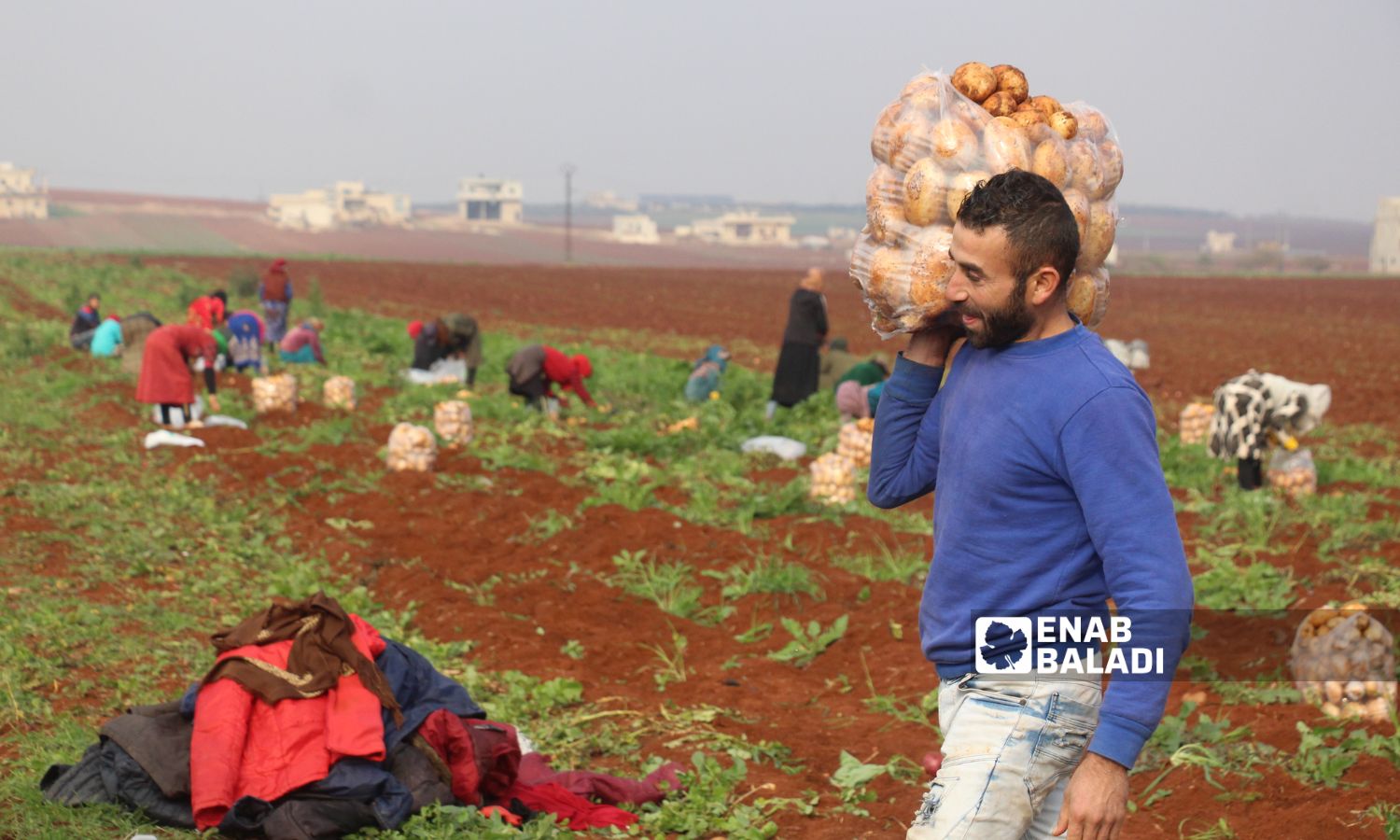
A farmer carrying potatoes on agricultural land in the town of Zardana, north of Idlib – December 25, 2022 (Enab Baladi/Iyad Abdul Jawad)
Cotton crop is abandoned
The problems facing the cotton crop in Syria continue, which is considered the second strategic crop after wheat.
Numbers conflict about the quantity of production, as data from a study published by the regime’s ministry of agriculture in 2006 indicate that Syria’s cotton production in 2004 amounted to more than one million tons, while data from the International Production Evaluation Division of the US Department of Agriculture indicate that al-Hasakah governorate produces 38% of the total cotton production in Syria, followed by Raqqa with 24%, then Aleppo with 16%.
Production declined during the war years, as it did not exceed 56,000 tons by 2023 in regime-controlled areas, according to the head of the Professional Union of Textile Workers, Muhammad Azouz.
In 2023, the regime’s government was unable to pay the value of cotton marketed by farmers to its institutions, with the quantities delivered reaching about 1,100 tons, after it raised the purchase price per kilo from 4,000 pounds to 10,000 pounds (70 USD cents).
The AANES set 80 USD cents per kilogram (About 11,000 pounds) without announcing the purchase of the crop while allowing it to be exported outside those lands.
In Idlib, the Salvation Government set the purchase price of one kilogram of cotton at 70 USD cents and decided to buy the crop from farmers, with expectations that production would reach about 500 tons.
The Interim Government did not set a price for cotton or its desire to buy the crop, and the price per kilo ranged between 50 and 55 USD cents, which left farmers and the crop vulnerable to exploitation by merchants.
Beetroot is animal feed
This year’s strategic sugar beet crop ended up as animal feed after the regime’s government refused to receive it, even though it set its purchase price at 400 Syrian pounds per kilo.
The amount supplied by farmers to the Tal Salhab sugar factory amounted to 6,552 tons, and the economic committee in the regime’s government recommended that the General Fodder Corporation receive this year’s beetroot crop and pay its price to the farmers.
The Damascus government attributed the reason to the decline in the cultivation of the crop in sufficient areas to produce abundant production that contributes to moving the wheel of rotation of the Tal Salhab sugar factory.
Given the limited production, the committee deemed it useless to operate the factory.
Olive is declining
Syria ranked fourth in the world among olive-producing countries from 2004 to 2008 and ranked fifth in the world in its production in 2011, after Spain, Italy, Greece, and Turkey. Its ranking fell to seventh place in 2018, and production then reached 899,000 tons.
This year, olive production across the entire area of Syria is estimated at about 711,000 tons, including about 304,000 tons in areas under the control of the regime, resulting in 49,000 tons of olive oil for local consumption, according to Abeer Jawhar, the director of the olive office in the agriculture ministry.
The number of olive trees in Syria is about 106 million, of which 82 million are fruitful, according to the ministry’s statistics.
Citrus fruits: Depression and damage
Every year, citrus production, whose cultivation is concentrated in the cities of the Syrian coast, accumulates among farmers and is exposed to rot and damage, causing them great losses without effective governmental solutions.
There is no government pressing factories in Syria to benefit from the production and squeeze it to sell it locally or export it. The production of citrus fruits this season is estimated at 825,000 tons, and the price of a kilo of Citrus Aurantium oranges, one of the most sought-after types, does not exceed 2000 pounds, which is equivalent to the price of one egg.

Wheat harvest in the lands of the al-Rouj Plain, south of Idlib – June 4, 2023 (Enab Baladi/Iyad Abdul Jawad)
Four reasons: Conflict, costs, climate and “governments”
Enab Baladi polled the opinions of agricultural engineers residing in different geographical areas, including engineer Khaled Suleiman, who attributed the reasons for the decline of the agricultural sector to several factors, most notably the high cost of production requirements, such as fuel, equipment, fertilizers, medicines, transportation fees, labor, and others.
As for fuel, the Daraa-based engineer said that it has become a major challenge for farmers, and its costs are considered a large margin of the expected profit for agricultural crops, as the price of a liter of diesel has reached 14,000 pounds, while the quantities of subsidized diesel provided by the agriculture directorate to farmers do not meet their minimum needs.
According to Suleiman, the high prices were not limited to diesel fuel. Rather, the prices of fertilizers and medicines rose, prompting farmers to ignore their use, which affected the quality and quantities of the crop.
The engineer added that the price of a bag of fertilizer reached one million Syrian pounds, in addition to other supplies that were associated with the same price, which increased the farmers’ losses.
He added to Enab Baladi that neglecting to nourish the land with these materials impoverished the soil and made it have low fertility, and this affected the quantities and types of crops.
In the southern Daraa governorate, in particular, the engineer considered that one of the factors that greatly affected the sector was the drought of water, especially in the western countryside, where most of the springs, lakes and hundreds of wells dried up, which prompted some farmers to be content with growing winter crops only.
Mahmoud, an agricultural engineer based in northeastern al-Hasakah governorate, told Enab Baladi that the war greatly affected the agricultural sector and destroyed the agricultural infrastructure.
The military operations played a role in the migration of part of the population from their rural areas, who were working in this vital sector, which left a negative impact on the sector in the region.
The engineer, who declined to reveal his full name for security concerns, added that Syria recorded a shortage of water resources as a result of the deterioration of irrigation infrastructure, which weakened the ability to cultivate and the quality of crops, in addition to the climate changes that Syria was exposed to, such as periods of drought and floods, which affected the ability of agricultural lands to support agricultural production.
The deterioration of the value of the Syrian pound played a major role in the rise in production costs and the difficulty of accessing agricultural resources and the necessary technology.
Dr. Firas Shaabo, a Ph.D. in banking and finance, told Enab Baladi that the policy adopted by the Syrian regime after 2011 towards the Syrian revolution, of burning crops and destroying agricultural structures, put the entire agricultural sector in danger.
Shaabo added that this policy made Syria and the Syrians unable to secure their basic needs of agricultural crops, and also harmed the Syrian economy as a whole.
Among the most prominent damages that have affected the Syrian economy over the past years is that Syria has lost a source of income for foreign exchange through exporting agricultural products abroad, according to the economist.
These repercussions increased the deficit of the Syrian economy and the Syrian individual alike, as the state as a system became unable to secure the basic needs of Syrians, and supply in the markets decreased, and consequently, prices rose for Syrians, coinciding with the deterioration of the Syrian pound and other deteriorating economic conditions.
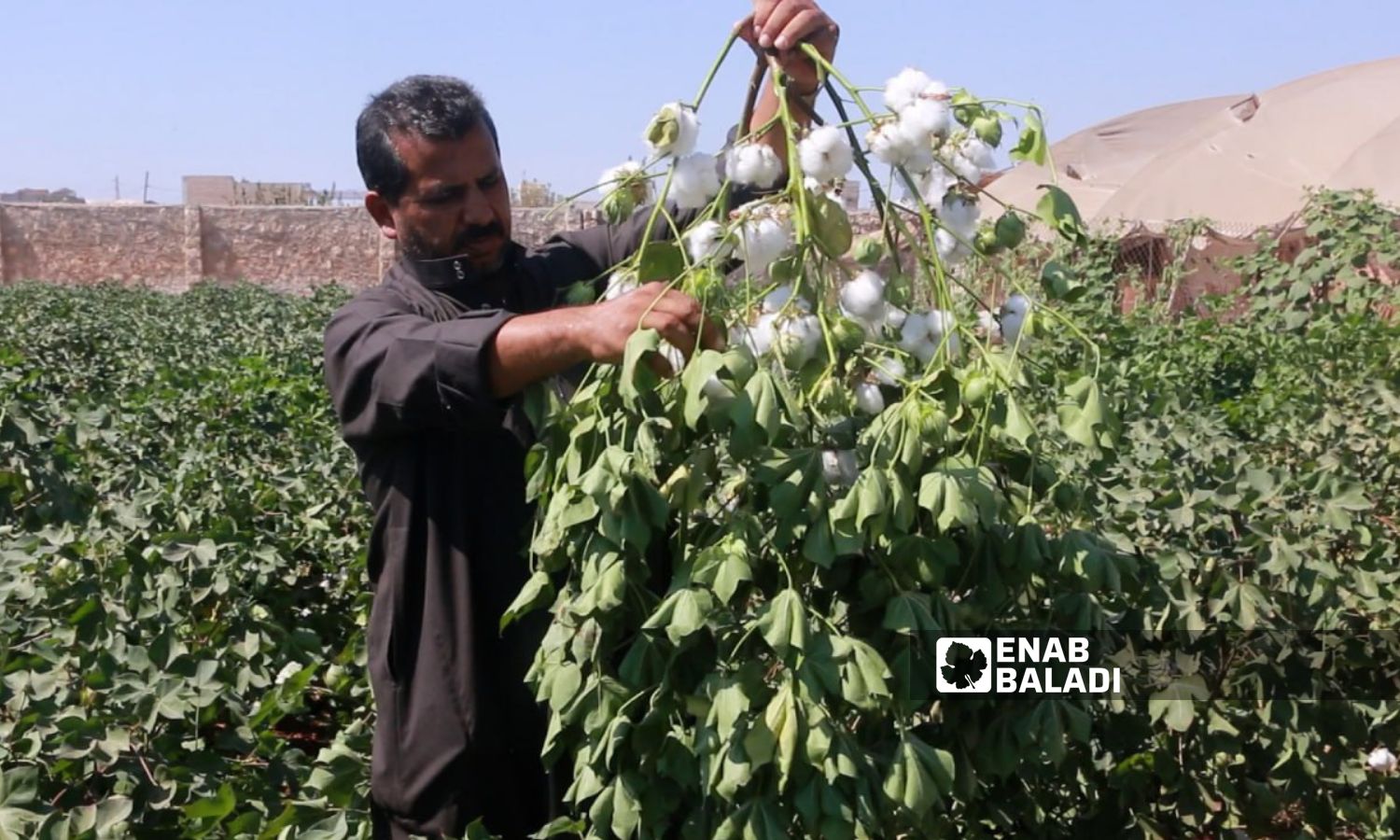
Cotton picking in the city of Idlib, northwestern Syria – October 2023 (Enab Baladi/Anas al-Khouli)
How did the decline in agriculture affect Syria?
Agriculture in Syria constituted 33% of the GDP in 1970 and decreased to 27% in 2001, according to a study published by the Economic Sciences Group. Then, its contribution to the GDP decreased to 17.6%, and about 17% of the total labor force was working in the agricultural sector, i.e., approximately 900,000 workers, according to official estimates released in 2010.
The area of arable land in 2010 amounted to six million and 45,000 hectares, and it increased in 2011 to become six million and 68,000 hectares, according to data provided by the regime’s agriculture ministry.
The same statistics did not record a radical difference in 2020, as the ministry said that arable land in Syria in 2020 amounted to 6,071,000 hectares.
From the south of Syria, which is controlled by the regime, through the center of the country to its north, farmers’ complaints about their losses with every harvest reverberate due to the lack of services provided by the authorities.
Farmers’ losses mainly affected the lives of people in general, who search for a few kilograms of a specific agricultural commodity as an ingredient for their meal.
With the passage of time, environmental and service conditions worsen the reality experienced by farmers in Syria, to the point that some of them have moved away from working in this sector, as happened with farmers interviewed by Enab Baladi.
Faisal Tammo, 45, a farmer of al-Hasakah, told Enab Baladi that working in agriculture in his Karbawi village was a major source of income for most of the residents of his village during the years that preceded the start of the Syrian revolution.
Tammo added that he and other farmers he knew were able to achieve self-sufficiency, but the situation in the past is not similar to the current situation due to the drought and years of drought that the region experienced, which affected strategic crops.
Given the current situation, some farmers decided to abandon the cultivation of specific types of crops, due to the high costs of some basic necessities for crop production, while other farmers decided to abandon this profession completely because the losses exceeded the profits.
Hundreds of kilometers to the south, the situation was no different, as Youssef al-Salem, a farmer in the western countryside of Daraa, decided to leave the agricultural profession two years ago after irrigation water dried up and production requirements became expensive, and he turned to raising livestock, including cows and sheep.
Ahmed Kiwan, for the same reasons, changed his field of work from the agricultural sector to trade and opened a store that sells foodstuffs because agriculture no longer covers its costs, and continuing to work in it leads to a real loss.
Kiwan added that it is illogical to buy a meter of organic fertilizer for a million Syrian pounds, given that the farmer’s profits go to pay off debts for products he borrowed from the agricultural pharmacy.
While farmers on the Syrian coast are impatiently awaiting the citrus harvest season for which their region is famous, to secure their families’ needs and to pay off their debts accumulated over the months of cultivation, the prices of the products have decreased, according to what farmers told Enab Baladi. This made some of them prefer to keep their fruits on trees rather than sell them at low prices, causing them great losses.
In northwestern Syria, new crops such as saffron, roses, sage, and rosemary have entered, taking their place instead of strategic crops that no longer generate profits.
Losses for the farmer, the consumer and the economy
Agricultural engineer Mahmoud, who lives in al-Hasakah, considered that the decline in the agricultural sector in Syria and the increasing challenges faced by farmers could affect the sustainability of the sector in general.
Mahmoud said that this impact begins with a decline in farmers’ income, which makes it difficult for them to continue their work in agriculture and leads to workers in sectors related to agriculture losing their jobs, especially in areas where agriculture is a major source of income.
The engineer believes that the decline of the agricultural sector in the region has broad implications for the consumer and the local economy, such as the rise in food prices, which is reflected in the costs of living for consumers, which leads to a shortage of some basic foodstuffs and a decline in the gross domestic product of the region or the entire sector.
Economist Shaabo believes that the new reality has changed the order of Syrians’ priorities at the local table, in addition to the fact that reality itself has begun to control the quantity of these same priorities.
Based on what the farmers and agricultural engineers interviewed by Enab Baladi said, the deterioration of the agricultural sector over the past years has been reflected in the lives of farmers, and thus in their products and in the prices of goods in the markets.
These repercussions did not stop at the Syrian individual’s wallet. Dr. Shaabo believes that the successive effects of the decline in the agricultural sector affected the economy in general, which turned the regime’s government toward importing to fill the local market’s inability to produce after it had been exporting these same goods.
The import strategy created a new problem because it relied on foreign exchange, which is not available in the state treasury, and if it is available, it is widespread on the black market at double its prices.
Therefore, merchants sell their products at the black market exchange rate, not at the declared price, which causes a significant increase in prices, making the citizens helpless about buying a lot of their needs.

Wheat grains in the hands of a farmer in the al-Rouj Plain, south of Idlib – June 4, 2023 (Enab Baladi/Iyad Abdul Jawad)
No sustainability plans in past; No economic plans today
Indicators, numbers, complaints, and an economic reality that has been declining for the worse for more than 12 years in Syria reveal much about the suffering of farmers and their seasonal losses without a solution or compensation.
The issue is limited to the farmer’s decision, which ranges between continuing farming and investigating the crop that returns capital and a little profit or stopping and waiting with unsubstantiated hopes for an improvement in the reality of the agricultural sector.
A 2016 study by the US National Aeronautics and Space Administration (NASA) concluded that the recent drought that began in 1998 in the eastern Mediterranean region, which includes Cyprus, Jordan, Lebanon, Palestine, Syria, and Turkey, was likely the worst drought in the past nine centuries.
In September 2021, a study was released that reported that unprecedented drought caused by climate change, exacerbated by upstream irrigation, was wreaking havoc on some of the world’s oldest river-fed farmlands in Syria and Iraq.
The drought in 2021 is also considered the worst in 70 years and is more serious than the drought that occurred between 2006 and 2009, in the years before the revolution in Syria.
All of these factors address the climatic aspect of the issue, to which is added the military situation in Syria for more than a decade which has negatively affected the ability of farmers to continue their agricultural work and invest in their lands for many reasons.
In addition to the absence of governmental solutions, and the absence of plans that save the farmer from losses that may be caused by weak production due to nature and weather, lack of care for economic reasons, or surplus production without the ability to market.
Agricultural engineer Samer Kaakarli, former employee in the regime’s agriculture ministry, told Enab Baladi that the issue of the loss of the Syrian farmer is divided into two parts, before and after the revolution. Crops are also divided into two types: strategic, marketed through the government, such as wheat, sugar beets, and cotton. Before Bashar al-Assad’s rule, the crops were barley and corn and non-strategic, such as vegetables and fruits.
These crops, which are marketed through the state, were not a loss to their farmers before the revolution, according to Kaakarli. The method of sale was through the Directorate of Agricultural Economics, and it has a cost study department to study the cost of an agricultural dunum at the level of seeds, cultivation, medicines, etc., and the rent of the land.
This is done in order to estimate the cost of a hectare and its average production in ten years, irrigated and rain-fed, then arrive at the cost of a kilogram, and to present the numbers to the Economic Committee, which adds 25% to these costs and determines the price.
As for sugar beets, it has a special status, due to the dispute over the percentage of cutting the beets and the percentage of sweetness, that is, the percentage of sugar.
This was unfair to the farmers, and it is related to the work of the ministry of industry. For example, when ten tons of beets are harvested from agricultural land, they are cut, and the “vegetative total” is determined. This means a decrease in weight, and as for the percentage of sweetness, there were long lines waiting in front of the factories for days and the sweetness of beets decreases with time, and the percentage of sugar decreases.
When the farmer arrives at the time of delivery and inspects the crop, the low sugar content causes the factory to refuse to receive the crop, which means turning it into fodder, at a necessarily lower price than its supposed price.
After switching to the Social Market Economy system, the government moved to put pressure on the agriculture ministry to reduce costs, and the ministry resisted this idea. But things changed with time. There is what is called “land rent,” meaning the farmer rents the land or invests it annually, an item that was refused to be added to the study of costs.
The government also demanded a reduction in labor wages, given that the Syrian farmer works on his land with his wife and children, and all of this is in order to reach a low state price.
However, despite the Agricultural Bank’s delay in paying the price of the wheat and cotton crops, it cannot be said that the farmer was a loser, according to the engineer Kaakarli.
At the level of secondary crops, such as vegetables, fruits, and fruit trees, the farmer incurred losses, due to the lack of a government plan.
Experts say that the Marketing Directorate in the Ministry of Agriculture was created relatively late and that government plans were only concerned with marketing wheat, cotton, and beets, and the rest of the crops had no marketing plan.
The idea of marketing was based on “promote what you plant,” while the rule should be “plant what you can market or promote.”
The first principle was putting farmers in front of a big bump, related to the surplus and the price falling below the cost, as a result of the increase in supply, and this was happening to the tomato crop in Daraa and citrus crops in the coast, and these are cases in which the government does not usually intervene.
Regarding natural disasters, the state did not intervene, and established a fund to support agricultural production and an accident fund. The initial capital of the first was high to compensate farmers, and its intervention was not significant except in the coast to compensate owners of greenhouses, with the absence of the fund’s work for farmers in other areas that faced frost waves.
During the citrus season, the government was putting a moral effort into marketing citrus while leaving major crops without marketing committees, such as the tomato crop in Daraa, the main crop, and apples (the main crop in As-Suwayda governorate, the mountainous Zabadani region, and others.)
In light of this, farmers from various regions were suffering from depression as a result of the abundance of the product and the absence of marketing channels, and citrus fruits were not suitable for export because the production did not match the desires of many consumers of other countries.
There was also difficulty in changing the type of agriculture, and a lack of will. In the eighties and nineties of the last century, the cultivation of citrus and olives was encouraged, but the olive crop could be squeezed, and as for citrus fruits, there were no factories that would deal with their surplus to turn them into juices, for example, according to engineer Kaakarli.
The environment and climate also affected the loss of farmers, but the biggest factor is the absence of plans and the lack of anyone to bear responsibility.
Sufficiency in production; Poverty of tools
During the Syrian revolution, the economic collapse occurred, and after the assassination of the former Lebanese Prime Minister, Rafik Hariri, the French President at the time, Jacques Chirac, threatened to impose unprecedented sanctions on Syria, which really frightened the regime, so it asked the ministries to submit reports, each in its sector, on the potential effects of European sanctions.
According to Kaakarli, who was an employee in the Ministry of Agriculture, the results were disastrous, agriculturally at least, because production requirements were imported, in addition to fertilizers and pesticides of all kinds, and even packaging requirements were imported, which can be measured in reality, in light of the deterioration of the value of the local currency and the import of production requirements, which means production costs will rise significantly.
During the revolution, the farmer’s suffering increased with the economic collapse as a result of the regime’s war, the weakness of purchasing power and the decline in the value of the currency, and drug smuggling within fruit and citrus shipments reduced the desire of other countries to import fruits and vegetables from Syria.
Despite the regime’s renewed control over some areas, there are still farmers far from their agricultural lands, some of which are dotted with military points. There are areas in the Hama countryside where fields have been left to plunder and investment by other groups, in light of the owner’s absence or not being allowed to access his land.
if you think the article contain wrong information or you have additional details Send Correction
النسخة العربية من المقال
-
Follow us :













 Wheat harvest in the al-Rouj Plain in the northwestern Idlib region - June 4, 2023 (Enab Baladi/Iyad Abdul Jawad)
Wheat harvest in the al-Rouj Plain in the northwestern Idlib region - June 4, 2023 (Enab Baladi/Iyad Abdul Jawad)





 A
A
A
A
A
A
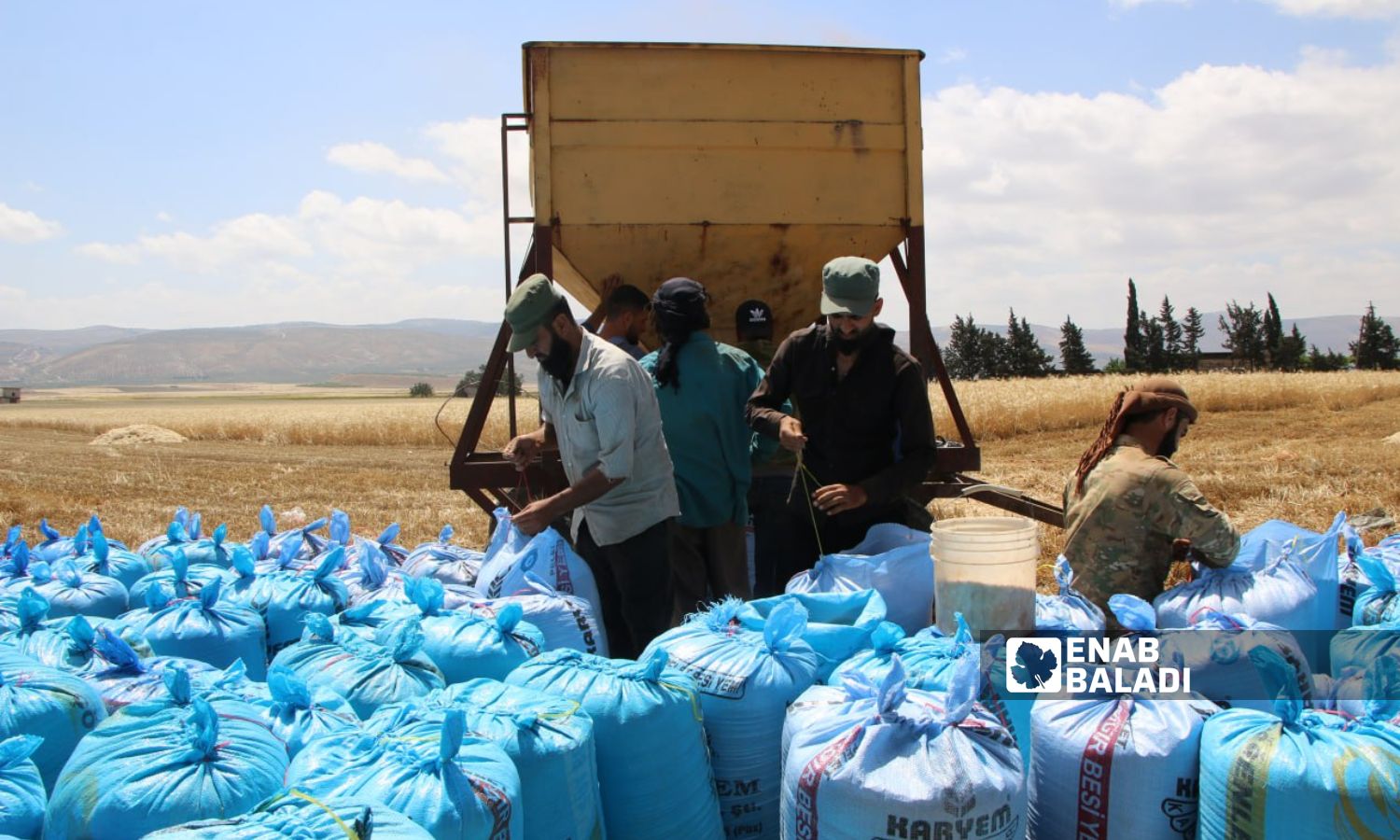



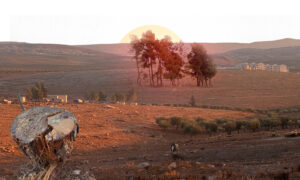
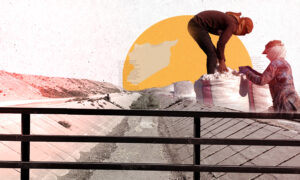

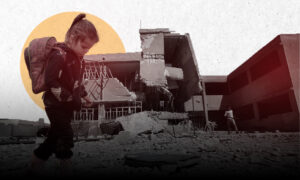
 More In-Depth
More In-Depth